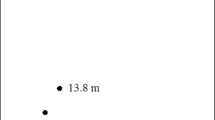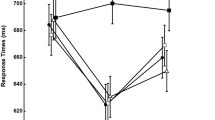Abstract
While mechanisms of orienting attention in unilateral spatial neglect (USN) have frequently been studied in the visual domain, these mechanisms remain relatively unexplored in the auditory domain. Our first goal was to replicate Spence and Driver’s (J Exp Psychol Hum 22:1005–1030, 1994) results with a virtual reality paradigm. This paradigm simulated a 3-dimensional auditory space with headphones. Our second aim was to study auditory profiles of orienting attention in USN. In a first experiment, 18 healthy participants performed an auditory cueing spatial paradigm (either a target-detection task or a target-lateralization task). In a second experiment, 14 right-stroke patients (10 with USN and 4 without USN) performed these two same tasks. As in Spence and Driver’s (J Exp Psychol Hum 22:1005–1030, 1994), our first experiment showed that spatial representations are not utilized for the detection of auditory stimuli. However, during the lateralization task, participants were quicker to detect targets preceded by a spatially congruent cue, which suggests that our paradigm could be suitable for studying orienting attention in hearing. Our second experiment found that patients with USN also needed an explicit spatial task to be sensitive to auditory spatial cueing. In the target-lateralization task, they showed effects lateralized only to one side of space, whereas patients without USN did not. Although our paradigm needs replications to better understand orienting attention impairments in hearing in USN, this study could have implications for the development of clinical tasks that could assess auditory spatial attention in USN syndrome.



Similar content being viewed by others
References
Azouvi P, Bartolomeo P, Beis JM, Perennou D, Pradat P, Rousseaux M (2006) A battery of test for the quantitative assesment of unilateral neglect. Restor Neurol Neurosci 24:273–285
Bartolomeo P, Chokron S (2002) Orienting of attention in left unilateral neglect. Neurosci Biobehav Rev 26:217–234
Bartolomeo P, Siéroff E, Dacaix C, Chokron S (2001) Modulating the attentional bias in unilateral neglect: the effects of the strategic set. Exp Brain Res 137:432–444
Bellmann A, Meuli R, Clarke S (2001) Two types of auditory neglect. Brain 124:676–687
Bisiach E, Cornacchia L, Sterzi R, Vallar G (1984) Disorders of perceived auditory lateralization after lesions of the right hemisphere. Brain 107:37–52
Chokron S, Colliot P, Bartolomeo P, Rhein F, Eusop E, Vassel P, Ohlmann T (2002) Visual, proprioceptive and tactile performance in left neglect. Neuropsychologia 40:1965–1976
Crawford JR, Garthwaite PH (2002) Investigation of the single case in neuropsychology: confidence limits on the abnormality of test scores and test score differences. Neuropsychologia 40:1196–1208
De Renzi E, Faglioni P, Scotti G (1970) Hemispheric contribution to exploration of space through the visual and tactile modality. Cortex 6(2):191–203
De Renzi E, Gentillini M, Barbieri C (1989) Auditory neglect. J Neurol Neurosur Psychiatry 52:613–617
Diller L, Weinberg J (1977) Hemi-inattention in rehabilitation: the evolution of a rational remediation program. Adv Neurol 18:63–82
Eramudugolla R, Irvine D, Mattingley J (2007) Association between auditory and visual symptoms of unilateral spatial neglect. Neuropsychologia 45:2631–2637
Gainotti G, D’Erme P, Bartolomeo P (1991) Early orientation of attention toward the half space ipsilateral to the lesion in patients with unilateral brain damage. J Neurol Neurosur Psychiatry 52:1082–1089
Gainottti G (2010) The role of automatic orienting of attention towards ipsilesional stimuli in non-visual (tactile and auditory) neglect: a critical review. Cortex 46:150–160
Guilbert A, Clément S, Moroni C (2014) Hearing and music in unilateral spatial neglect neuro-rehabilitation. Front Psychol 5:1503
Hochstenbach J, Mulder T, Van Limbeek J, Donders R, Schoonderwaldt H (1998) Cognitive decline following stroke: a comprehensive study of cognitive decline following stroke. J Clin Exp Neuropsychol 20(4):503–517
Losier B, Klein R (2001) A review for a disengage deficit following parietal lobe damage. Neurosci Biobehav R 25:1–13
Lupianez J, Milan EG, Tornay FJ, Madrid E, Tudela P (1997) Does IOR occur in discrimination tasks? Yes, it does, but later. Percept Psychophys 59:1241–1254
Lupianez J, Milliken B, Solano C, Weaver B, Tipper SP (2001) On the strategic modulation of the time course of facilitation and inhibition of return. Q J Exp Psychol 54A:753–773
Miller JD (2001) SLAB: a software-based real-time virtual acoustic environment rendering system. In: Proceedings of the 2001 international conference on auditory display, Espoo, Finland, July 29–August 1, 2001
Niemi P, Näätänen R (1981) Foreperiod and simple reaction time. Psychol Bull 89:133–162
Pavani F, Husain M, Làdavas E, Driver J (2004) Auditory deficits in visuospatial neglect patients. Cortex 40:347–365
Pizzamiglio L, Antonucci G, Judica A, Montenero P, Rzzano C, Zoccolotti P (1992) Cognitive rehabilitation of the hemilneglect disorder in chronic patients with unilateral right brain damage. J Clin Exp Neuropsychol 14:901–923
Posner MI (1980) Orienting of attention. Q J Exp Psychol 32:3–25
Posner MI, Cohen Y (1984) Components of visual orienting. In: Bouma H, Bouwhuis DG (eds) Attention perform X. Erlbaum, Hillsdale, pp 531–555
Posner M, Petersen SE (1990) The attention system of the human brain. Annu Rev Neurosci 13:25–42
Posner MI, Snyder CR, Davidson BJ (1980) Attention and the detection of signals. J Exp Psychol 109(2):160–174
Posner M, Walker J, Friedrich F, Rafal R (1984) Effects of parietal injury on covert orienting of attention. J Neurosci 4:1863–1874
Rasquin S, Lodder J, Ponds R, Winkens I, Jolles J, Verhey F (2004) Cognitive functioning after stroke: a one-year follow-up study. Dement Geriatr Cogn 18:138–144
Spence C, Driver J (1994) Covert spatial orienting in audition: exogenous and endogenous mechanisms facilitate sound localization. J Exp Psychol Hum 22:1005–1030
Welford A (1980) Choice reaction time: basic concepts. In: Welford A (ed) Reaction times. Academic Press, New York, pp 3–128
World Medical Association (2013) World medical association declaration of helsinki: ethical principles for medical research involving human subjects. JAMA 310(20):2191–2194. doi:10.1001/jama.2013.281053
Acknowledgments
This work is supported by a grant from “Métropole Européenne de Lille – MEL”
Author information
Authors and Affiliations
Corresponding author
Ethics declarations
Conflict of interest
The authors declare that the research was conducted in the absence of any commercial or financial relationships that could be construed as a potential conflict of interest.
Rights and permissions
About this article
Cite this article
Guilbert, A., Clément, S., Martin, Y. et al. Exogenous orienting of attention in hearing: a virtual reality paradigm to assess auditory attention in neglect patients. Exp Brain Res 234, 2893–2903 (2016). https://doi.org/10.1007/s00221-016-4691-8
Received:
Accepted:
Published:
Issue Date:
DOI: https://doi.org/10.1007/s00221-016-4691-8




